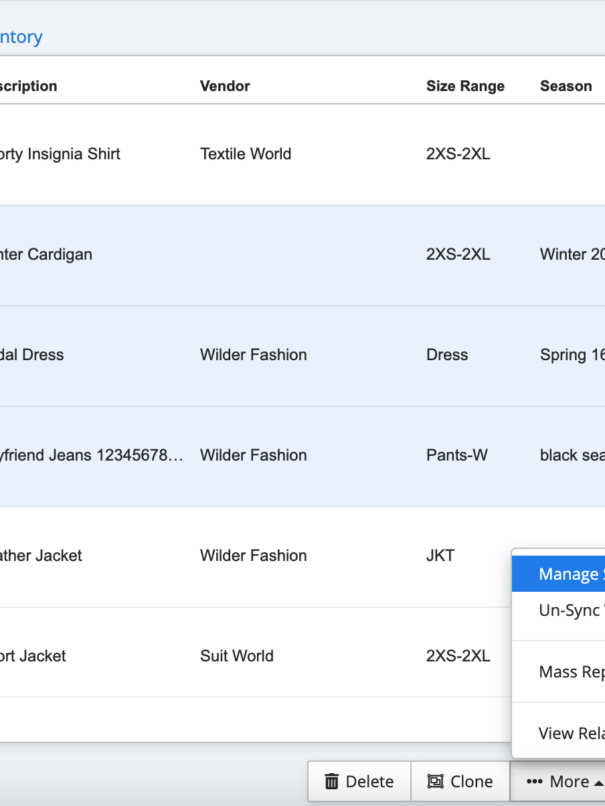We are in an era where fashion brands are set up for success or failure based on their ability to adapt to changing consumer preferences and behavior. The ability to navigate this $1.7 billion industry does not solely rely on a brand’s insights into customer behavior and desires; it’s about keeping up with the latest and predicting future apparel trends, and pinpointing where the current will flow. This is easier said than done when we are talking about the ever-changing apparel industry trends.
In the current market, success hinges on maximizing eCommerce opportunities. Statistics show that the online apparel segment enjoys a staggering amount of users, or, to be precise, 2.7 billion. This indicates just how big of a factor eCommerce will play in the grand scheme of retail.
While it’s important for fashion brands to take advantage of this growing trend or miss out on important gains, they have to be on their toes and pinpoint other emerging trends that might help them improve multiple aspects of their business operations.

Use of Artificial Intelligence to Enhance Customer Experience
With the rise of artificial intelligence, fashion brands no longer have to grapple with challenges in presenting their products in the perfect light. Thanks to AI, businesses can continuously enhance and improve the customer experience so they offer a more enjoyable shopping journey.
Still, AI is an untested technology, and many still hesitate to take advantage of its potential. However, history has shown us that customer journey experiences are significantly improved when personalization comes into play – something made easy through the implementation of artificial intelligence solutions.
Let’s explore some game-changing tactics you can use to deliver a better experience on all fronts.
Forecast Trends
AI has the potential to revolutionize the way apparel companies forecast fashion trends. By analyzing vast amounts of data from social media, eCommerce platforms, and other sources, AI algorithms can identify patterns and predict which styles and designs will likely be popular in the coming months or years.
This can help apparel companies make more informed decisions about which products to develop and market, reducing the risk of investing in styles that may not resonate with consumers at that particular time.
In a way, AI can help you stay one step ahead and never make a false move, stocking the closets of prospects with only trendy and captivating fashion pieces that have heads turning.
To put things into perspective, let’s say a celebrity wore a waterfall cardigan at that event, you can rest assured that the demand for such cardigans will skyrocket, and being prepared to ride that wave will only boost your sales rapidly.
Forecasting manually can be extremely difficult, you need to have a solid supply chain software solution in place that will give you access to in-depth analytics and therefore help you forecast future apparel industry trends effortlessly.
Personalized Sizing and Fitting Through AI and AR Technology
As retailers attempt to improve customers’ experiences, personalized fashion item sizing and fitting have become increasingly popular. Companies can use 3D models and animations to allow customers to virtually try on clothes, reducing the environmental impact associated with traditional methods. AI-driven algorithms are also used to offer personalized suggestions that help increase sales and offer buyers a more tailored experience.
Augmented reality and AI technology allow for improved clothes-fitting experiences, helping retailers become more eco-friendly by reducing textile waste.
This try-before-you-buy method works well, and it can help both customers and retailers as there will be no back and forth; your customer base knows exactly what they are getting and what kind of experience they will enjoy with the fashion pieces they purchase.
Sustainability
AI can help you analyze each step of your business operations, from sourcing your material to manufacturing and shipping it to your loyal customers. It can show you how and where sustainability can be improved and help you take action against the serious threat of climate change.
Now, it may come to you as a surprise that fashion needs to be at the forefront of climate action efforts as 10% of global emissions are happening because of this industry. Crafting a sustainable fashion brand can help you make waves with environmentally aware millennials faster, so why not be ahead of the curve?
Help you with Pricing
Today’s retail market is increasingly competitive, and it is essential for retailers to use AI-powered rich data to create personalized product offerings and pricing strategies that meet the needs of each customer and market segment.
By leveraging insights into customer preferences, purchasing habits, and demographic characteristics, retailers can take a more targeted approach to their product and pricing decisions.
Additionally, data-driven business analytics can help retailers optimize inventory levels and reduce price cut-downs. Through AI-powered rich data, retailers have access to unprecedented amounts of information and capabilities that can be used to increase sales and improve profits.
Utilizing this information enables them to accurately identify customer interests, prioritize products, devise strategies for enticing customers with discounts or promotions, and even anticipate future trends in the marketplace. Armed with these valuable insights, retailers are better prepared than ever to compete in a crowded marketplace.
Chatbots
Turning to chatbots and personal assistants to engage with clients and improve customer service is not unheard of in the online retail sector. In a way, this technology can be viewed as having a dedicated virtual assistant on your site, helping prospects navigate easily through it.
This method is already popular; 70% of millennials said they have interacted with chatbots and that their experience was positive, which indicates a bright future for these virtual assistants. Chatbots offer a great solution for merchants looking to enhance customer satisfaction and brand loyalty by providing 24/7 assistance, answering frequently asked questions, and offering rewards based on customer intent.
While personal connections are valuable, chatbots offer numerous benefits, such as increased availability and decreased latency.

Emerging Trends Outside AI
The fashion industry is quite the shape-shifter, constantly transforming itself to keep up with ever-evolving tastes. AI may have made its mark on the fashion industry, but it’s not taking all of the credit. Several popular trends are happening throughout different industries that can’t be ignored.
1. M-commerce
There’s an argument to be made that shopping anxiety still exists as the last few years have drastically changed the way we buy and sell goods. During the pandemic, retailers had to find a way to optimize the shopping experience, and they have succeeded in doing so by promoting m-commerce. Not only have they made shopping simpler and more convenient, but they’ve also created a whole new range of digital experience opportunities.
For example, the widespread adoption of digital wallets such as Apple and Android Pay is shifting consumer behavior by offering a faster and more secure way to pay for goods online.
What’s more, social platforms such as Instagram and Facebook have integrated digital commerce into their platforms, giving brands a new way to reach out to customers. Meanwhile, apps like Vinted have revolutionized the online sales industry by providing consumers with an easier way to buy and sell second-hand fashion items from their smartphones.
This demonstrates how both retailers and individuals can revolutionize this sector with the help of mobile commerce and drive innovation, leading to an increase in convenience and helping the sector grow.
2023 might just be the year to look into transforming your store. The convenience you can offer customers by allowing them to browse, enjoy and purchase via their handheld devices can establish you as the business leader to follow in the apparel industry, opening the doors to your shop for all shopping experiences.
2. Recommerce
This model is commerce focused on people reselling their gently used clothing items to others through online platforms. It’s an environmentally friendly way to shop, as it reduces waste and the carbon footprint associated with clothing production. Additionally, this approach can be more affordable for consumers who are looking for high-quality designer pieces at a lower price point.
As more people become aware of the benefits of recommerce in fashion, it’s expected that this trend will continue to grow in popularity and influence traditional retail models. Some fashion brands have even started their own resale platforms or partnered with existing ones to provide a sustainable option for their customers. With consumers becoming increasingly conscious of the environmental impact of fast fashion, recommerce is poised to be a game-changer in the fashion industry.
A Trend That is Here to Stay
It’s easy to focus on the future in the search for the next big retail trend; however, taking what works and using it to your advantage will always pay off. One such trend is using an apparel management system.
Retailers face many challenges when it comes to managing their inventory and operations. Poorly managed inventory can lead to lost sales, higher costs, and inefficiency. To tackle these issues, retailers must have a reliable apparel management software solution that can help them manage every part of their business, from bookkeeping to pattern management. Such a system should be tailored to an apparel business’s needs and enable them to easily track orders, items, costs, shipments, and more. With the right apparel management software solution in place, retailers can save time and money and improve the efficiency of their operations.
Without the help of this software, fashion retailers can expect to face challenges in many forms, such as:
- Poor inventory management can lead to lost sales, higher costs, and inefficiency for retailers.
- Retailers need a reliable apparel management software solution to manage their business effectively.
- The software should be tailored to the specific needs of an apparel business.
- The software should enable retailers to track orders, items, costs, and shipments more easily.
- By implementing the right apparel management software solution, retailers can save time and money and improve efficiency in their operations.
Bottom Line
For fashion brands to thrive, they need to adapt to changing consumer preferences and behaviors. One crucial factor is maximizing eCommerce opportunities, especially with the emergence of artificial intelligence as a useful technology. Fashion companies can leverage AI to enhance customer experience and improve business operations by revolutionizing trend forecasting, offering personalized sizing and fitting, promoting sustainability, optimizing pricing strategies, and utilizing chatbots for increased customer satisfaction.
Apparel industry trends that are here and shaping the future should not be overlooked. An all-in-one apparel management software will help you boost efficiency and ensure that each step of your business operation is thoroughly environmentally friendly and see a huge ROI.
Finally, emerging trends like m-commerce should not be overlooked either. In this ever-evolving industry, fashion companies that stay ahead of the curve by adopting emerging technologies and trends are more likely to succeed.







